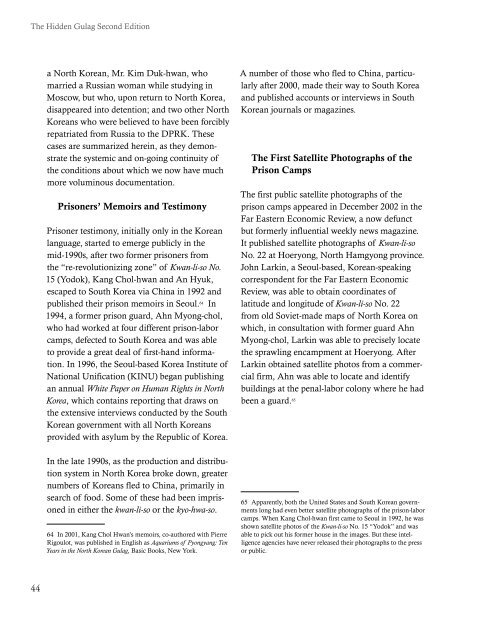The Hidden Gulag - US Committee for Human Rights in North Korea
The Hidden Gulag - US Committee for Human Rights in North Korea
The Hidden Gulag - US Committee for Human Rights in North Korea
You also want an ePaper? Increase the reach of your titles
YUMPU automatically turns print PDFs into web optimized ePapers that Google loves.
<strong>The</strong> <strong>Hidden</strong> <strong>Gulag</strong> Second Editiona <strong>North</strong> <strong>Korea</strong>n, Mr. Kim Duk-hwan, whomarried a Russian woman while study<strong>in</strong>g <strong>in</strong>Moscow, but who, upon return to <strong>North</strong> <strong>Korea</strong>,disappeared <strong>in</strong>to detention; and two other <strong>North</strong><strong>Korea</strong>ns who were believed to have been <strong>for</strong>ciblyrepatriated from Russia to the DPRK. <strong>The</strong>secases are summarized here<strong>in</strong>, as they demonstratethe systemic and on-go<strong>in</strong>g cont<strong>in</strong>uity ofthe conditions about which we now have muchmore volum<strong>in</strong>ous documentation.Prisoners’ Memoirs and TestimonyPrisoner testimony, <strong>in</strong>itially only <strong>in</strong> the <strong>Korea</strong>nlanguage, started to emerge publicly <strong>in</strong> themid-1990s, after two <strong>for</strong>mer prisoners fromthe “re-revolutioniz<strong>in</strong>g zone” of Kwan-li-so No.15 (Yodok), Kang Chol-hwan and An Hyuk,escaped to South <strong>Korea</strong> via Ch<strong>in</strong>a <strong>in</strong> 1992 andpublished their prison memoirs <strong>in</strong> Seoul. 64 In1994, a <strong>for</strong>mer prison guard, Ahn Myong-chol,who had worked at four different prison-laborcamps, defected to South <strong>Korea</strong> and was ableto provide a great deal of first-hand <strong>in</strong><strong>for</strong>mation.In 1996, the Seoul-based <strong>Korea</strong> Institute ofNational Unification (KINU) began publish<strong>in</strong>gan annual White Paper on <strong>Human</strong> <strong>Rights</strong> <strong>in</strong> <strong>North</strong><strong>Korea</strong>, which conta<strong>in</strong>s report<strong>in</strong>g that draws onthe extensive <strong>in</strong>terviews conducted by the South<strong>Korea</strong>n government with all <strong>North</strong> <strong>Korea</strong>nsprovided with asylum by the Republic of <strong>Korea</strong>.In the late 1990s, as the production and distributionsystem <strong>in</strong> <strong>North</strong> <strong>Korea</strong> broke down, greaternumbers of <strong>Korea</strong>ns fled to Ch<strong>in</strong>a, primarily <strong>in</strong>search of food. Some of these had been imprisoned<strong>in</strong> either the kwan-li-so or the kyo-hwa-so.64 In 2001, Kang Chol Hwan’s memoirs, co-authored with PierreRigoulot, was published <strong>in</strong> English as Aquariums of Pyongyang: TenYears <strong>in</strong> the <strong>North</strong> <strong>Korea</strong>n <strong>Gulag</strong>, Basic Books, New York.A number of those who fled to Ch<strong>in</strong>a, particularlyafter 2000, made their way to South <strong>Korea</strong>and published accounts or <strong>in</strong>terviews <strong>in</strong> South<strong>Korea</strong>n journals or magaz<strong>in</strong>es.<strong>The</strong> First Satellite Photographs of thePrison Camps<strong>The</strong> first public satellite photographs of theprison camps appeared <strong>in</strong> December 2002 <strong>in</strong> theFar Eastern Economic Review, a now defunctbut <strong>for</strong>merly <strong>in</strong>fluential weekly news magaz<strong>in</strong>e.It published satellite photographs of Kwan-li-soNo. 22 at Hoeryong, <strong>North</strong> Hamgyong prov<strong>in</strong>ce.John Lark<strong>in</strong>, a Seoul-based, <strong>Korea</strong>n-speak<strong>in</strong>gcorrespondent <strong>for</strong> the Far Eastern EconomicReview, was able to obta<strong>in</strong> coord<strong>in</strong>ates oflatitude and longitude of Kwan-li-so No. 22from old Soviet-made maps of <strong>North</strong> <strong>Korea</strong> onwhich, <strong>in</strong> consultation with <strong>for</strong>mer guard AhnMyong-chol, Lark<strong>in</strong> was able to precisely locatethe sprawl<strong>in</strong>g encampment at Hoeryong. AfterLark<strong>in</strong> obta<strong>in</strong>ed satellite photos from a commercialfirm, Ahn was able to locate and identifybuild<strong>in</strong>gs at the penal-labor colony where he hadbeen a guard. 6565 Apparently, both the United States and South <strong>Korea</strong>n governmentslong had even better satellite photographs of the prison-laborcamps. When Kang Chol-hwan first came to Seoul <strong>in</strong> 1992, he wasshown satellite photos of the Kwan-li-so No. 15 “Yodok” and wasable to pick out his <strong>for</strong>mer house <strong>in</strong> the images. But these <strong>in</strong>telligenceagencies have never released their photographs to the pressor public.44



